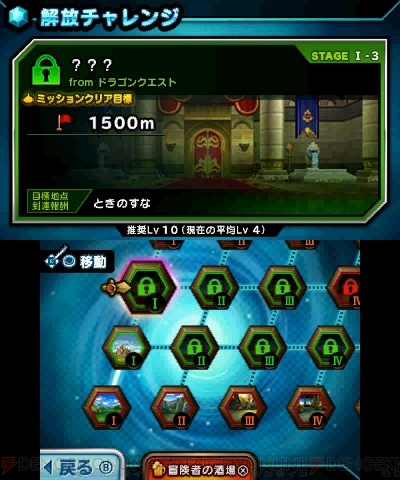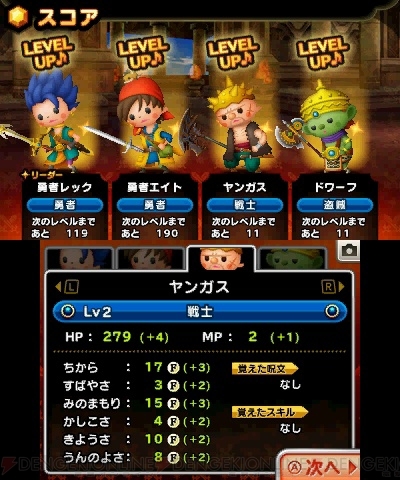The beat approaches! Command?
It's hard not to compare Theatrhythm Dragon Quest to its Final Fantasy counterpart. I feel like I shouldn't, and I don't want to, but ignoring Theatrhythm Final Fantasy is impossible—much the same way that evaluating Dragon Warrior and Final Fantasy separately felt impossible back in the 1980s. They're siblings in every way. Academic as the approach might not be, we're only humans, and the fact is, during my time with Theatrhythm Dragon Quest, reminders of Theatrhythm Final Fantasy's snappier menus and smoother game progression were around every turn.
There's this strange phenomena about Dragon Quest. No matter what the genre, no matter what system or what year it is, these games always have the slowest, least efficient menus possible. This is particularly mind-boggling in the case of Theatrhythm, because quite seriously the only other game in this franchise had a much faster, more player-friendly menu. But DQ gonna DQ, and Theatrhythm Dragon Quest's menus all come with obstacles seemingly thrown in with the sole purpose of slowing the player down.
Unskippable fanfares take upwards to 10 seconds to play out before you can move on, simple tasks like seeing what you unlock take an ungodly amount of time, and all for no discernable reason. Why can't I press a button to move the menu forward after I see that I got a tiny medal? Why do I have to sit through the same fanfare every single time that happens, especially when it's going to happen in chunks of several at a time? That's annoying free-to-play/pay-to-win shit and doesn't belong on software for a dedicated gaming system.
The most important part of this would of course be the music, and overall, TDQ delivers. Fans will recognize the 50 songs as the best and most fun of the series. So if you're here for nostalgia, TDQ will let you reminisce fondly.
Less fun, though, is that there are only 10 tracks available from the start, with the rest unlocked by clearing the other songs in a somewhat prescribed order. Meanwhile in Theatrhythm Final Fantasy, a whole pile of songs opened after clearing just four. (In Curtain Call, 200 opened up at that point.) More could be unlocked later, but there was a gigantic pile of music available by comparison. Going from that mountain of tracks to only a handful gives a feeling of limitation.
Tracks are unlocked from a grid which isn't quite linear, but not totally free either. Players unlock songs by completing missions, and new missions only open up by clearing adjacent missions, limiting freedom to unlock the songs you like most. As you start in one corner of the board, naturally the tunes from Dragon Quest VIII, IX, and X will be the furthest away and take the longest to unlock, no matter what you do.

RPG stats and random elements are more important in Theatrhythm Dragon Quest than they were in Final Fantasy. Those who want hardcore strategizing and careful selection of the party and its skills might like the change, while those who would rather just play the stages and unlock new songs would probably not be as high on it. For example, it's possible to clear a song but not clear the mission, which means that even though you perfectly performed the song, you didn't defeat the boss due to your characters' stats.
This discourages changing the party, because new characters start at level one. Bringing in a new face, therefore, comes at the cost of being held back. This makes it more like an RPG and less like a rhythm game, but on the other hand, said rhythm game has "Dragon Quest" in the title, so it could be seen as a good thing.
The majority of tracks are arranged versions; no pre-PlayStation originals are to be found within Theatrhythm Dragon Quest. There is one free DLC song in its original 8-bit form, but the rest are arrangements which, while nice, begin to sound a bit samey. The arrangements are great to have, but it would have been nice to have either multiple versions of the songs, or some be arranged and others in their original styles. It would've spiced things up nicely. And, once again, that's something Theatrhythm Final Fantasy did particularly well. Sometimes the punch of those 8- and 16-bit tunes just can't be beat.

Familiar Theatrhythm Battle, Field, and Event stages are all back, but a Dragon Quest change was made to the Battle play. Instead of notes coming from the left side of the screen to the right as they do in Theatrhythm Final Fantasy, the Dragon Quest take has notes coming from top to bottom, more reflective of the Dragon Quest series, whose battles play out in a first-person view. It makes timing a little bit harder to judge, but that comes with the territory. It also falls in line with lots of other music games, so there's no harm there. All around, it's a great thematic move that doesn't much alter the mechanics.
The graphics are beautiful, and the characters all look super cute in the signature Theatrhythm art style. Monsters haven't been quite as chibi-fied as the playable characters have and maintain their tremendous charm. Dragon Quest has always been bright, colorful, and good-looking, so it's nice to see Theatrhythm continue the trend.
A new "Simple Mode" takes out all use of the directional triggers, essentially turning Theatrhythm into a one-button game. For those that want it or need it, this adds a lot of accessibility. The inclusion takes nothing away from players who aren't interested, but adds important approachability for others. Nice.

Also new is the pleasant diversion "Sugoroku," a cute one-player board game similar to a lightweight Mario Party. Roll dice, move along, get rewards, unlock things, and try to reach the end. Upon completion, the party may challenge a boss for a chance to double the rewards. An average round of this could take anywhere from two to five minutes, depending on how the dice fall.
Theatrhythm Dragon Quest changes up the Theatrhythm formula enough and contains enough music to please its fanbase. Those who've played Theatrhythm Final Fantasy Curtain Call might see 50 songs as a bit small and might not like the heavily arranged soundtrack, but the additions of a whole new franchise's worth of characters, tunes, backgrounds, and enemies can balance it out. It looks pretty and plays well, and that's what matters most.
-
All the feels of an almost 30-year-old series
-
Almost entirely arranged music
-
Bright, colorful, looks great
-
It's like they try to make these menus as slow as possible
-
Unlocking songs somewhat tedious
-
RPG elements more important than in Theatrhythm Final Fantasy
-
Simple Mode adds accessibility
-
Sugoroku
Theatrhythm Dragon Quest Review
-
Theatrhythm Dragon Quest Review #1

-
Theatrhythm Dragon Quest Review #2

-
Theatrhythm Dragon Quest Review #3

-
Theatrhythm Dragon Quest Review #4

-
Theatrhythm Dragon Quest Review #5

-
Theatrhythm Dragon Quest Review #6

-
Theatrhythm Dragon Quest Review #7

-
Theatrhythm Dragon Quest Review #8

-
Theatrhythm Dragon Quest Review #9

-
Theatrhythm Dragon Quest Review #10

-
Theatrhythm Dragon Quest Review #11

-
Theatrhythm Dragon Quest Review #12

-
Theatrhythm Dragon Quest Review #13

-
Theatrhythm Dragon Quest Review #14

-
Theatrhythm Dragon Quest Review #15

-
Theatrhythm Dragon Quest Review #16

-
Theatrhythm Dragon Quest Review #17

-
Theatrhythm Dragon Quest Review #18

-
Theatrhythm Dragon Quest Review #19













